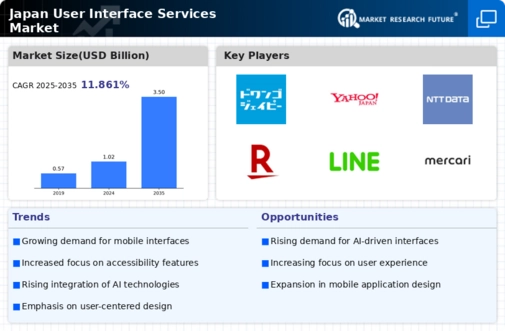The user interface-services market in Japan is characterized by a dynamic competitive landscape, driven by rapid technological advancements and an increasing demand for intuitive design solutions. Major players such as Adobe (US), Figma (US), and Sketch (US) are at the forefront, each adopting distinct strategies to enhance their market presence. Adobe (US) focuses on innovation through continuous updates to its Creative Cloud suite, integrating AI capabilities to streamline design processes. Figma (US), on the other hand, emphasizes collaboration and cloud-based solutions, appealing to remote teams and fostering a community-driven approach. Sketch (US) maintains a strong foothold by prioritizing user experience and offering tailored solutions for mobile and web design, thereby shaping a competitive environment that thrives on innovation and user-centric design.
The market structure appears moderately fragmented, with a mix of established players and emerging startups. Key business tactics include localizing services to cater to regional preferences and optimizing supply chains to enhance efficiency. This collective influence of major companies fosters a competitive atmosphere where agility and responsiveness to market demands are crucial. The interplay between these tactics and the competitive structure suggests a landscape where adaptability is paramount for sustained growth.
In October 2025, Adobe (US) announced the launch of a new AI-driven feature within its design platform, aimed at automating repetitive tasks for designers. This strategic move is likely to enhance productivity and attract a broader user base, positioning Adobe (US) as a leader in innovation within the user interface-services market. The integration of AI not only streamlines workflows but also aligns with the growing trend of digital transformation across industries.
In September 2025, Figma (US) expanded its partnership with major tech firms to enhance its collaborative features, allowing for seamless integration with other design tools. This strategic action underscores Figma's commitment to fostering a collaborative ecosystem, which is increasingly vital in a remote work environment. By enhancing interoperability, Figma (US) strengthens its competitive edge and appeals to a diverse range of users seeking efficient design solutions.
In August 2025, Sketch (US) introduced a new subscription model that offers tiered pricing based on user needs, aiming to attract both individual designers and large teams. This strategic shift reflects an understanding of market demands for flexibility and affordability, potentially increasing its market share. By catering to various user segments, Sketch (US) positions itself as a versatile player in the user interface-services market.
As of November 2025, current trends such as digitalization, sustainability, and AI integration are reshaping the competitive landscape. Strategic alliances among companies are becoming increasingly common, facilitating innovation and resource sharing. The shift from price-based competition to a focus on technological advancement and supply chain reliability is evident. Moving forward, competitive differentiation will likely hinge on the ability to innovate and adapt to evolving user needs, suggesting a future where technology and creativity converge to redefine user interface services.

















Leave a Comment